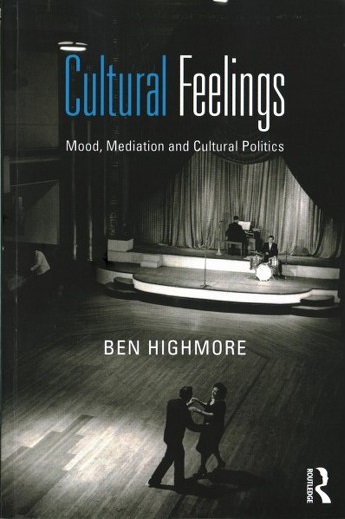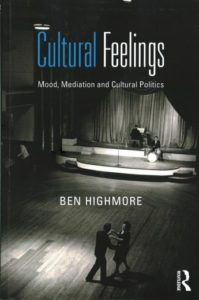

Right away, Ben Highmore’s book confronts us with the questions: can feelings be cultural? Can they be anything but? This book sets out to examine the role of feelings and mood in the production of social and cultural experiences. The author’s monograph presents an engaging theoretical treatment, linking Raymond Williams to affect theory to Heidegger, providing a distinct theoretical framework through which to approach a set of distinct case studies. From the beginning, the author clarifies that he is not interested in thinking about moods or feelings as internal or individualized states; instead, he writes that, “we live across mood-words” (1). Highmore constructs a plural subject, the “we” that populates the previous sentence, in the inaugural pages of his work. As such, he pushes us to think about the cultural, social, and historical aspects of feelings and moods. In doing so, he joins a number of scholars who are thinking about affect, feeling, and emotions as experienced by collectivities, as opposed to confined to our internal selves.
Highmore makes a number of provocative and ultimately productive choices for his project. First, he chooses to use the terms “feeling” and “mood” over “affect.” He does so because these terms are vague and allow the author to move between habituated and the emotional, the quotidian and the intense aspects of lived experience. In effect, this choice allows Highmore to interject himself into extant debates without having to take up the full mantle of their theoretical commitments. This enables the author to interrogate the cultural aspects of feelings and moods without being beholden to the theoretical commitments of those scholars before him. This helps to unpack a central tension in extant literature, between the general experience of emotions at a national level, and the specific articulation of their effects among different groups and individuals.
Second, Highmore chooses Raymond Williams’ “structures of feeling,” Martin Heidegger’s “Stimmung” or “mood,” and affect theory and new materialism as anchoring his as theoretical contribution. This is a provocative choice insofar as it is a combination that frequent travelers in the world of affect, emotions, and feelings do not often encounter. Of course, Williams’ structures of feeling animate a large swatch of work in this area, but it is not often paired with Heidegger. Highmore’s treatment of Williams allows him to emphasize the idea that feelings cannot and do not exist outside of their historical context. His argument is weakened slightly by an extensive detour into the term’s genesis; the author’s theoretical engagement with Williams is strong, and does not require the bibliographical background also included in the chapter. However, Highmore more than makes up for this minor misstep when he places Williams in conversation with Heidegger, a move not common in this area of the academic terrain. The engagement with Heidegger allows Highmore to further develop the collective aspect of feelings that punctuates his work. Further, it gives more purchase to his claim that feelings are historical, one developed through the engagement with Williams as well. Placing these two thinkers in conversation with one another draws out their relevant similarities, but also bolstered the theoretical underpinnings of Highmore’s work.
The final sections of Highmore’s theory chapter present a brief description of some major works in the way of affect theory. In one sense, Highmore makes an effective choice in this section, by focusing on the work of Lauren Berlant. He does so, evidently, because Berlant’s work is both historically-grounded and engages Williams ways similar to his project. However, this section of the chapter is barely five pages, offering a brief description of the genesis of affect theory before moving onto Berlant. It raises two important questions: first, can five pages do this rich body of scholarship justice; and second, and related, is Highmore really using affect theory to ground his project if the engagement is so minimal? The second question is resolved over the course of the monograph; it is clear that this body of scholarship animates the way he thinks about feelings as collective, cultural, and historical. The first question remains, but the high quality of scholarship that populates the bulk of Highmore’s book eclipses its significance.
The third choice that Highmore makes surrounds the case studies that occupy most of the monograph. These choices are varied, provocative, and ultimately productive, because they allow the author to develop different aspects of his theory. In pursuit of cultural feelings, the book moves along a trajectory through four registers of cultural feelings: space, time, narration, and moments (137). These registers emphasize the material, social and historical nature of all moods and feelings. Cultural feelings never belong to any of these particular registers, but each of these registers helps to underscore the significance of the work Highmore does in this monograph. Highmore’s first case study chapter explores the feelings that circulated at the specific historical moment (WWII), and how these feelings both shaped and were shaped by the work of morale-building. This case study draws out the reciprocal nature of feelings and mood-work, which is an important contribution to the broader field of study. The second case study chapter interrogates the theme of destruction and the way cultural feelings become embedded in landscapes and spaces. By focusing on the bombsites and playgrounds that emerged following WWI, Highmore is able to draw out the way our commitments to certain narratives become inscribed in the very landscape that we live, and how the landscape might work to inscribe its own narratives. Highmore recognizes that the cultural politics that emerges at these sites of destruction is not one searching for re-enchantment, but instead one of pragmatism and even melancholy. This is an honest appraisal of British cultural politics, constructed through a helpful case study analysis.
Highmore’s third case study chapter takes up the experience of migration in twentieth century Britain, stepping outside of the historical moment of the first two case studies. This helps the author demonstrate his range, in terms of historical context and subject matter. The bulk of the chapter unfolds through archives, which the author takes as material support for patterns of feeling. This also introduces a different set of material considerations that stand apart from the work of the earlier chapters. The fourth case study chapter turns to punk and post-punk to elaborate an additional aspect of cultural feelings. In this chapter, the author moves his inquiry outside a specific geographic area and period of time, to analyze the way sounds, rhythms and gestures are productive of feelings. In particular, Highmore interrogates the musical traits of post-punk in an attempt to capture the energies and the moods at play. This chapter is ambitious, and at times fractured, but also reveals a challenge felt by many scholars who traffic in this intellectual area: it is difficult to describe moods and feelings, things that are primarily felt. The translation of feelings into articulate speech is a difficult task, encountered by most scholars in this field. In many ways, Highmore’s varied and elaborate case study chapters help him overcome this obstacle, but there are places where the narratives fall short, which is a function of the subject matter, and more common than not in this kind of intellectual pursuit.
Overall, this book represents an ambitious attempt to tease out the cultural experience of moods and feelings, an experience that can and should be part of any political project. Highmore’s work makes a number of important choices, and in turn, contributions to the study of moods, feelings, emotions and affects. Though the monograph experiences some slight issues, in general, this is a strong piece by a gifted theorist and empiricist alike. Ultimately, Highmore demonstrates a dynamic way to marry theoretical insights with diligent empirical inquiry. Through the empirical chapters, Highmore’s theory comes alive, and becomes felt, in the way cultural feelings are meant to be.
Reviewed by Danielle Hanley, University of Pennsylvania
Cultural Feelings: Mood, Mediation, and Cultural Politics
by Ben Highmore
Publisher: Routledge
Paperback / 182 pages / 2017
ISBN: 9780415604123
To read more book reviews, please click here.
Published on April 17, 2018.




